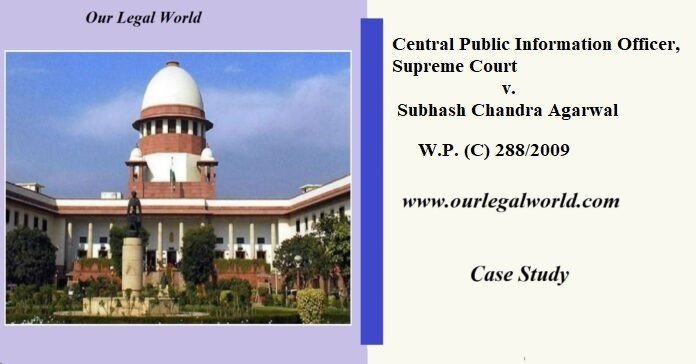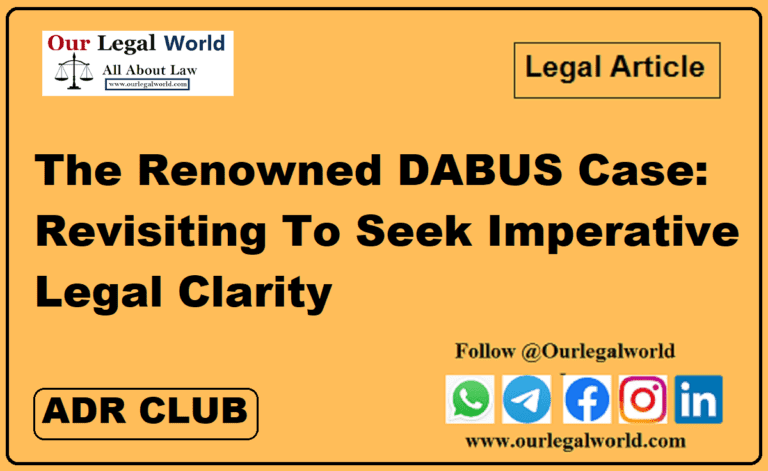CPIO, Supreme Court v. Subhash Chandra Agarwal
CPIO /Central Public Information Officer, Supreme Court v. Subhash Chandra Agarwal CJI Office comes under RTI Act 2020
IN THE SUPREME COURT OF INDIA
CIVIL APPEAL NO. 10044 OF 2010
W.P. (C) 288/2009
Petitioner
Central Public Information Officer, Supreme Court Of India
Respondent
Subhash Chandra Agarwal
Date of Judgement
13 November, 2019
Bench
Ranjan Gogoi, C.J.I; V. Ramana, J.; D.Y. Chandrachud, J.; Deepak Gupta, J.; Sanjiv Khanna, J.
INTRODUCTION
This is a landmark case that determines the balance between the right to information guaranteed to all individuals with the principle of confidentiality. It focuses on transparency in all government institutions. More importantly, it strikes an equilibrium between the right to privacy, a recognized fundamental right, along with the larger interest of the public which would necessitate the disclosure of information. It addresses questions related to disclosure of information related to the appointment of judges, their assets revelation and correspondence of judges and other authorities in light of judicial independence.
FACTS
This case consist of three appeals, which arose from separate orders denying the required access to information under RTI Act. Appeals arised in this case were moved by Subhash Chandra Agarwal (respondent) before the central Public Information Officer (CPIO). The first of the appeals involved a right to information application filed by the respondent on the basis of a newspaper report. The respondent sought the complete correspondence of the Chief Justice of India regarding a Union Minister having allegedly approached Justice R Raghupati of the Madras High Court, through a lawyer, to influence a judicial decision.
The second appeal involved an RTI application request to furnish a copy of documents available with the Supreme Court. This included a correspondence between the relevant constitutional authorities relating to the appointment of various Supreme Court judges, superseding other senior judges. The third appeal involved an RTI application seeking information on a declaration made by judges of the Chief Justice of the Supreme Court and the Chief Justices in the States regarding the assets held by them, their spouses or any person dependent on them.
The first two appeals were filed against the order of the CIC directing access to information be granted and were initially denied. The third appeal was filed against the judgment of the full bench of the Delhi High Court, which had held that the office of the Chief Justice of India falls within the ambit of the term “public authority” under the RTI Act and allowed the access to information on declaration made by the judges to the Chief Justice of the Supreme Court and the Chief Justices in the States regarding the assets held by them, their spouses or any person dependent of them.
ISSUES RAISED
1. Is the information in the context of a collegium system for appointment and elevation of judges to the Supreme Court and the High Court’s; declaration of assets by judges, etc. protected under Right to Information Act, 2005?
JUDGEMENT
The Court dismissed Civil Appeal No.2683 of 2010 upholding the judgment of the Delhi High Court. The direction was given to the CPIO, Supreme Court of India by the CIC to furnish information on the judges of the Supreme Court who had declared their assets was upheld. The respondent was held to have the right to information under Section 2(j) of the RTI Act with regard to the information in the form of declarations of assets. It held that such disclosure would not encroach the personal information and right to privacy of the judges. The Chief Justice did not hold such declarations in a fiduciary capacity or relationship and in ter ms of Section 8(1)(e) of the RTI Act and that the information was neither protected under Section 8(j) of the Act.
Civil Appeal No.s 10045 of 2010 and 10044 of 2010 are partly allowed with an order of remit to the CPIO, Supreme Court of India to re-examine the matter after following the procedure under Section 11(1) of the RTI Act as the information relates to third parties. The concerned third parties are required to be issued notice and heard.
ARGUMENTS
The appellants argued the following points:
- Disclosure would impede the independence of judges. Judges ought not to be subjected to “litigative public debate,” and such protection is important for the functioning of the institution.
- Right to information is not an absolute right and is subject to restrictions and conditions under the RTI Act.
- As per section 8(1)(j) of the RTI Act, personal information, which has no bearing on any public activity or interest, are exempted from disclosure. As per the appellants, information on assets will fall within the purview of Section 8(1)(j) and hence is exempted. Further, disclosing information on the candidates being considered for judicial appointment would cause an unwarranted invasion of their privacy and does not serve the larger public interest.
- The information on assets is voluntarily declared by the judges to the Chief Justice of India in his fiduciary capacity as the pater familias of the judiciary. Additionally, information relating to the appointment of judges is shared among other constitutional functionaries in their fiduciary capacities, which makes the information exempt under Section 8(1)(e) of the RTI Act.
The respondent argued the following points:
- The respondent argued that the disclosure of the information sought does not undermine the independence of the judiciary. Rather, the transparency would be better for the independent functioning of the judiciary.
- The information sought serves the larger public interest and outweighs the privilege of exemption granted to personal information under Section 8(1)(j) of the RTI Act.
- There is no fiduciary relationship between the Chief Justice and the judges or among the constitutional functionaries as envisaged under Section 8(1)(e) of the RTI Act which could be a ground for holding back the information.
- Referencing the decisions in Central Board of Secondary Education and another v. Aditya Bandopadhyay and others[i] and Reserve Bank of India v. Jayantilal N. Mistry[ii] , the respondent argued that the “duty of a public servant is not to act for the benefit of another public servant.” [p. 9] As such, the Chief Justice and other functionaries should discharge their constitutional duties and not act as a fiduciary of anyone, except the people.
- If there exists a fiduciary relationship among the functionaries, disclosure can be made if it serves the larger public interest.
COMMENT
It was observed that the court falls under the definition of Public Authority under section 2(h) of the RTI Act. The CJI is the competent authority under 2(2)(ii) of the RTI Act. The court further observed the ‘Supreme Court’ will also include the office of the CJI and the judges. Hence, the office of CJI and the judges is not separate from the supreme court.
Also Read: Ajay Hasia Etc vs Khalid Mujib Sehravardi &; Ors:
The court affirmed the information is understood broadly to mean ‘material in any form’ which is accessible by the public authority and held by or under the control of any public authority. The court observed that any information on a private body, accessible by a public authority under any law, subject to applicable restrictions, will come within its purview. The court also observed that the expressions ‘held by or under the control of any public authority’ and information accessible under this act are restrictive and reflect the limit to the ‘right to information’ granted under section 3 of the RTI Act. Hence, the right to information is not an absolute right.
The constitution Bench of the Supreme Court of India held that the SC is a ‘public authority and hence will fall within the ambit of the right of information act, 2005. The court also held that the right to information should not be allowed to be used as a tool of surveillance to scuttle the effective functioning of the judiciary.
CONCLUSION
The Supreme Court took almost a decade to deliver this judgment. The judgment makes the CJI office more transparent and accountable to the people in the case of appointment. privacy and accountability must go hand-in-hand, transparency cannot triumph over the privacy and vice-versa. The judgment also maintains the dignity and privacy of judges. The bench unanimously held that the RTI is not an absolute right and there should be a proper balance between the right of the judges and transparency. And if any RTI filed seeks to infringe upon the right to privacy of judges that need not be answered. Even the question cannot be put before the judges to disclose the rationale of the judgment because that information is also not on record. The judgment clearly stated what information could be provided to the information seekers and declaring of assets does not constitute the “personal information” of the judges.[iii]
But despite this landmark judgment, the odds for misusing the RTI also escalate. RTI has ushered transparency. This judgment explicitly explained that information which is of immense public interest only needs to answer hence, fabricating the lesser chances of getting misused. Apart from opportunities to get misused this decision gave the classic instance for all other bodies and authorities to declare itself under the public authority, which will help to bring transparency. In the case of DAV College Trust and Managing vs. Director of Public Instructions[iv] apex court again make a good start, held that school and college are substantially financed public authority within the meaning of Section 2(h) of the Act. Transparency must be present within all three branches of government, i.e. legislative, executive and judiciary. RTI, in this, is a stalwart weapon that enriches the accountability and transparency. However, the Supreme Court has done a splendid job by announcing CJI office as part and parcel of public authority but we must spend some time to check the ground reality of RTI in the judiciary and Supreme Court.
The breakthrough of the Supreme Court for making the judiciary accountable isn’t made for the first time. The Apex Court in 2015 by the three-judge bench, including the erstwhile Chief justice of India Dipak Mishra, Justice A.M Khanwilkar and D.Y Chandrachud gave the judgment regarding the live streaming of court cases which are of constitutional importance.[v] This judgment was a huge step forward for maintaining the accountability of the Supreme Court to the people.
[i] (2011) 8 SCC 497
[ii] (2016) 3 SCC 525
[iii] Central Public Information Officer, Supreme Court of India v. Subhash Chandra Agarwal, 2019 SCC OnLine SC 1459.
[iv] 2019 SCC OnLine SC 1210.
[v] Swapnil Tripathi v. Supreme Court of India, (2018) 10 SCC 639.
https://indiankanoon.org/doc/136094148/
Author: Divya Nimbalkar This Case Comment was shortlisted in 1st Our Legal World National Case Comment Writing Competition 2020







